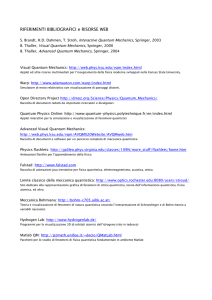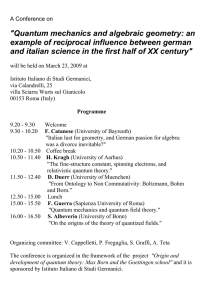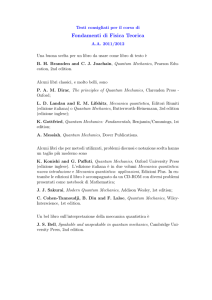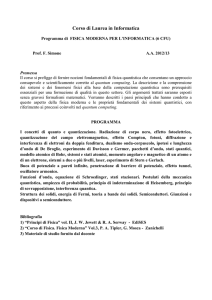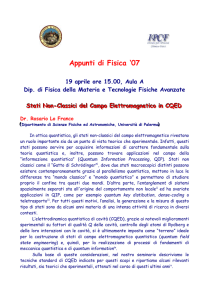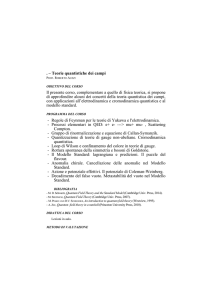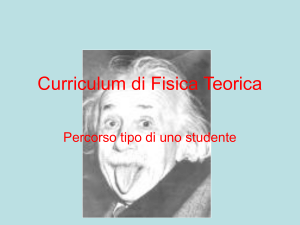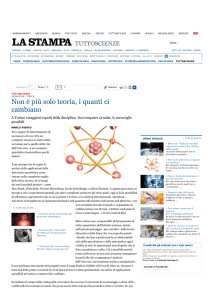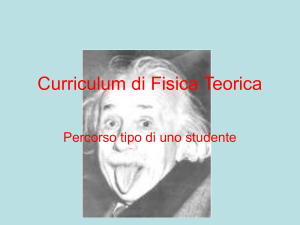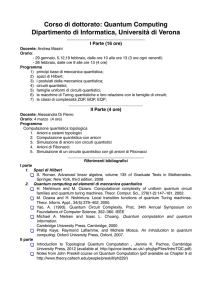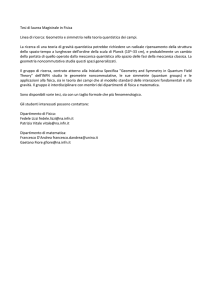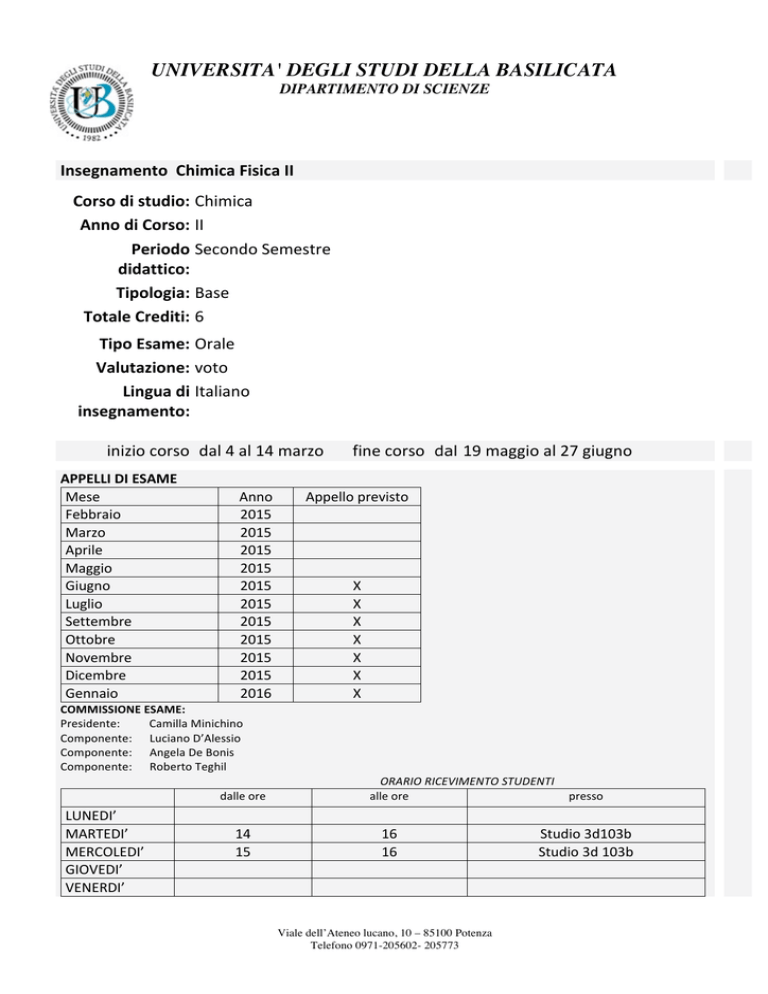
UNIVERSITA' DEGLI STUDI DELLA BASILICATA
DIPARTIMENTO DI SCIENZE
Insegnamento Chimica Fisica II Corso di studio: Chimica Anno di Corso: II Periodo Secondo Semestre didattico: Tipologia: Base Totale Crediti: 6 rale Tipo Esame: O
Valutazione: voto Lingua di Italiano insegnamento: inizio corso dal 4 al 14 marzo fine corso dal 19 maggio al 27 giugno APPELLI DI ESAME Mese Febbraio Marzo Aprile Maggio Giugno Luglio Settembre Ottobre Novembre Dicembre Gennaio Anno 2015 2015 2015 2015 2015 2015 2015 2015 2015 2015 2016 Appello previsto X X X X X X X COMMISSIONE ESAME: Presidente: Camilla Minichino Componente: Luciano D’Alessio Componente: Angela De Bonis Componente: Roberto Teghil LUNEDI’ MARTEDI’ MERCOLEDI’ GIOVEDI’ VENERDI’ dalle ore 14 15 ORARIO RICEVIMENTO STUDENTI alle ore presso 16 16 Studio 3d103b Studio 3d 103b Viale dell’Ateneo lucano, 10 – 85100 Potenza
Telefono 0971-205602- 205773
UNIVERSITA' DEGLI STUDI DELLA BASILICATA
DIPARTIMENTO DI SCIENZE
Eventuali prerequisiti Corsi Suggeriti: Chimica Generale, Matematica I e II, Fisica I e II. Obiettivi Formativi L’obiettivo del corso è quello di fornire una comprensione dei principi e delle tecniche della meccanica quantistica in modo da affinare le capacità di descrizione teorica della struttura e delle proprietà di atomi e molecole . Lo studente alla fine del corso deve dimostrare di a) conoscere i fondamenti della meccanica quantistica ed i modelli che sono alla base della teoria del legame chimico e della spettroscopia molecolare, b) comprendere l’importanza dell’uso della simmetria nello studio della struttura elettronica delle molecole, c) essere in grado di risolvere in maniera qualitativa e quantitativa semplici problemi di chimica quantistica. Programma del Corso Origini della teoria quantistica. Principi di meccanica quantistica nella rappresentazione delle coordinate di Schrödinger. L'equazione di Schrödinger indipendente dal tempo per sistemi monodimensionali in potenziali a segmenti costanti e sue applicazioni in chimica.L’oscillatore armonico e le vibrazioni molecolari. Il momento angolare orbitale ed il modello spettroscopico del rotatore rigido. Atomi idrogenoidi. Cenni sulla formulazione di Dirac della meccanica quantistica. Metodo variazionale e teoria perturbativa indipendente dal tempo. Momento angolare generalizzato, spin, composizione di momenti angolari, accoppiamento spin-­‐orbita. Sistemi con più particelle identiche, determinante di Slater come funzione d’onda per elettroni indipendenti e principio di esclusione di Pauli. Atomi polielettronici: separabilità e approssimazione orbitalica, configurazione elettronica, schemi di accoppiamento e stati elettronici. Simmetria molecolare e teoria dei gruppi. Introduzione alla struttura molecolare: separazione dei moti elettronici e nucleari, definizione e caratterizzazione della superficie di energia potenziale, la teoria degli orbitali molecolari, classificazione e costruzione qualitativa degli orbitali molecolari, metodo di Hückel, configurazioni elettroniche, stati elettronici e simboli di termine, principi base della teoria del legame di valenza. Panoramica sui metodi ab initio, semiempirici e DFT per il calcolo della struttura e delle proprietà molecolari. Metodi didattici lezioni frontali / esercitazioni per la risoluzione di problemi Modalità di verifica dell'apprendimento esame finale e verifiche parziali durante il corso Testi di Riferimento P. W. Atkins, P.W e Friedman,R. (2000), Meccanica Quantistica Molecolare. Zanichelli. Appunti e presentazioni del corso. Testi supplementari: Cohen-­‐Tannoudji, C.; Diu, B. e Laloe, F. (1977), Quantum mechanics. Vol. 1 e 2, Wiley Demtroder, W. (2010), Atoms, Molecules and Photons. II Edition, Springer. Feynman, R. P.; Leighton, R. B. e Sands, M. (2007), La fisica di Feynman. Vol 3:Meccanica Quantistica, Zanichelli. Holzner, S. (2010), Quantum Physics WorkBook For Dummies, Wiley. Larsson, S. (2012), Chemical Physics. Electrons and Excitations, CRC Press. Piela, L. (2007), Ideas of Quantum Chemistry, Elsevier. UNIVERSITA' DEGLI STUDI DELLA BASILICATA
DIPARTIMENTO DI SCIENZE
Rigamonti, A. e Carretta, P. (2009), Structure of Matter: An Introductory Course with Problems and Solutions: II Edition, Springer. Altre informazioni: ricevimento in altri orari/giorni da concordare con il docente via e-­‐mail ([email protected] COURSE Physical Chemistry II Course of Chemistry studies: UNIVERSITA' DEGLI STUDI DELLA BASILICATA
DIPARTIMENTO DI SCIENZE
Academic Year: 2014-­‐2015 ECTS: 6 Teaching Lectures – problems solving activities Methods: Evaluation final exam and evaluation tests during the course Methods: Evaluation: score on 30 points Semester: II Language: ITALIAN Course beginning on 4 -­‐ 14 march ending on 19 may -­‐ 27 june Calls for examination Month February March April May June July September October November December January Year 2015 2015 2015 2015 2015 2015 2015 2015 2015 2015 2016 Expected call x x x x x x x Examination Panel: President: Camilla Minichino Member: Luciano D’Alessio Member: Angela De Bonis Member: Roberto Teghil Previous requirements: General Chemistry , Mathematics I and II , Physics I and II. (Recommended courses) Learning Outcomes: The aim of the course is to provide a basic understanding of the principles and techniques of quantum mechanics in order to refine the skills in the theoretical description of the structure and properties of atoms and molecules. UNIVERSITA' DEGLI STUDI DELLA BASILICATA
DIPARTIMENTO DI SCIENZE
At the end of the course the students must demonstrate to a) know the fundamentals of quantum mechanics and the models that form the basis of the theory of chemical bonding and molecular spectroscopy; b) understand the importance of the use of symmetry in the study of the electronic structure of molecules; c) be able to solve qualitative and simple quantitative problems in quantum chemistry. Syllabus: Origins of the quantum theory. Postulates and some fundamental principles of quantum mechanics in the coordinate representation of Schrödinger. The time-­‐independent Schrödinger equation for one-­‐dimensional systems in piecewise constant potentials and its applications in chemistry. The harmonic oscillator and the molecular vibrations. The orbital angular momentum and the spectroscopic model of the rigid rotor. Hydrogen-­‐like atoms. Overview of Dirac formulation of quantum mechanics. Variational method and time-­‐independent perturbation theory. Generalized angular momentum, spin, the angular momentum in composite systems, spin-­‐orbit coupling. Identical particles and indistinguishability, Slater determinant as wavefunction of independent electrons and the Pauli exclusion principle. Polyelectronic atoms: separability and orbital approximation, electronic configuration, coupling schemes and electronic states. Molecular symmetry and group theory. Introduction to the molecular structure: separation between nuclear and electronic motions, definition and characterization of the potential energy surface, molecular orbital theory, classification and qualitative building of molecular orbitals, the Hückel method, electronic configurations, electronic states and molecular term symbols, basic principles of valence bond theory. Overview of ab initio, semiempirical and DFT methods for computing the electronic structure and properties of molecules. Suggested textbooks Atkins, P. & Friedman, R. (2005), Molecular Quantum Mechanics. IV Ed., Oxford University Press. Lecture Notes and presentations, Additional Readings: Cohen-­‐Tannoudji, C.; Diu, B. & Laloe, F. (1977), Quantum mechanics. Vol. 1 and 2, Wiley Demtroder, W. (2010), Atoms, Molecules and Photons. II Edition, Springer. Feynman, R. P.; Leighton, R. B. & Sands, M. (1964), The Feynman lectures on physics . Vol 3: Quantum mechanics, Addison-­‐W
Holzner, S. (2010), Quantum Physics WorkBook For Dummies, Wiley. Larsson, S. (2012), Chemical Physics. Electrons and Excitations, CRC Press. Piela, L. (2007), Ideas of Quantum Chemistry, Elsevier. Rigamonti, A. & Carretta, P. (2009), Structure of Matter: An Introductory Course with Problems and Solutions: II Edition, Springer. Further information:

